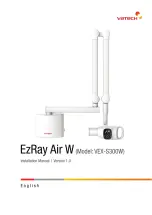
Xgard Air Sampling Unit (ASU)
Installation, Operating and Maintenance Instructions
M07646 Issue 2 Jan 06
Introduction
The Air Sampling Unit (ASU) is designed to be used with Crowcon’s Xgard range of detectors for monitoring
potentially hazardous gases within ventilation ducts. The ASU operates using the Venturi principle, for which the air
flow rate within the duct must be between 5 metres per second and 20 metres per second.
Installation
The following instructions assume that the ASU has been supplied with the Xgard detector pre-fitted. A full
assembly drawing is shown on the next page.
1. To avoid the adverse effects of turbulence, the ASU should be installed in the centre of a straight section of
duct which has a length of at least six times its width.
2. Check the air flow direction in the air duct system.
3. Apply the drilling template onto the centre line of the air duct parallel to the air flow. Check that the
directional arrow on the drilling template is the same as the direction of the air flow in the duct.
4. Using a centre punch, punch the two centres indicated for the drilling template.
5. Drill out to 25mm (1”) diameter. Remove burrs and sharp edges around the two holes.
6. Remove the ASU cover.
7. Fit the sample tube elbows with rubber washers on the inside and outside of the sampling chamber. Fit the
securing nuts and tighten. Ensure that the black sample tube holes face 180º away from the sample
chamber, and the white sample tube chamfer faces away from the sample chamber as shown on the
diagram on the next page.
8. Check the thickness of the air duct metalwork and fit the black rubber grommets into the two duct holes
drilled for point 5 of these instructions.
9. Fit the ASU probes through the two grommets checking that the inlet and outlet probes are correctly
installed and push until the unit has sealed.
10. Mark the six ASU plate fixing holes and drill 5mm (1/4”) holes for securing the plate. Secure the plate to the
duct using suitable bolts.
11. Connect the detector cable as instructed in the Xgard manual.
12.
Check that there is no air leakage into the sampling chamber from outside the duct through the
probe joints, grommets or sampling unit cover gasket.
Testing and Commissioning
Calibrate the detector according to its instructions. Testing the operation of the ASU can be performed by
introducing gas into the duct system.
Warning:
it is essential to ensure that procedures are in place to prevent people and/or equipment being affected
by any test gas introduced into the ventilation system.
Operation and maintenance
The ASU needs to specific maintenance, however the Xgard gas detector must be maintained in accordance with
its instructions.
Specifications
Xgard ASU Part Number:
S011843
Suitable Duct Widths:
300mm (12”) to 1500mm (60”)
Suitable Air Speeds:
5 metres (3’3”) per seconds to 20 metres (13’) per second
Operating Temperature Range: 0ºC (32ºF) to +60ºC (140ºF)
Note: this product is not compatible with the Xgard Type 4 high temperature flammable gas detector.
UK Office
Crowcon Detection Instruments
Ltd
2 Blacklands Way
Abingdon Business Park
Abingdon
Oxfordshire OX14 1DY
Tel: +44 (0)1235 557700
Fax :+44 (0)1235 557749
Email: [email protected]
Website: www.crowcon.com
USA Office
Crowcon Detection Instruments
Ltd
21 Kenton Lands Road
Erlanger
Kentucky 41018-1845
Tel: +1 859 957 1039 or
1-800-527-6926
Fax: +1 859 957 1044
Email: [email protected]
Website: www.crowcon.com
Rotterdam Office
Crowcon Detection Instruments
Ltd
Vlambloem 129
3068JG
Rotterdam
Netherlands
Tel: +31 10 421 1232
Fax: +31 10 421 0542
Email: [email protected]
Website: www.crowcon.net
Singapore Office
Crowcon Detection Instruments
Ltd
Block 192 Pandan Loop
~05-01 Pantech Industrial
Complex
Singapore 128381
Tel: +65 6745 2936
Fax: +65 6745 0467
Email: [email protected]
Website: www.crowcon.com
Crowcon reserves the right to change the design or specification of this product without notice.




















